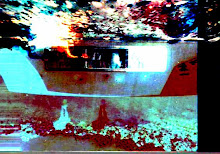Lily of the Valley (Convallaria majalis) is indeed the same name of a flowering plant that has a rich history and reputation that's intertwined with both the crucifixion and second coming of Christ, Germanic and Pagan mythology, and Breaking Bad. The plant's red berries are notorious for deceiving children as a small edible fruit that instead poisons its victims. I felt the plant's namesake would lend itself well to the album because of this deceptive nature, the idea of beauty belying a poisonous core.
As mentioned in my previous post, Lily of the Valley is an LP culled together from the recording sessions that started in summer 2012 and yielded a hefty batch of tracks varying in styles, moods and structures. The differing quality of this unwieldy collection of material would have made for a gargantuan album far more excessive in its self-indulgence than my previous LP effort, the double album The Lygath Tree. Appropriately, I realized that the material could be divided up into three distinct groups: ambient drones (which became my previous release the EP Dragonscales & Lambskin), psychedelic freak folk of a sort (which became this album), and songs largely inspired by krautrock and post-punk (which will become the next LP soon to be titled and completed).
As described, the songs of Lily of the Valley are predominantly psychedelic in texture and freak folk in structure although I would say this is perhaps the more obvious way to describe them because I used an acoustic guitar for most if not all of the songs. I feel as though the resulting tracks have a delicate and bittersweet quality to them generally, with gentle or emotional melodies that almost sound like wordless ballads to me. To think about these songs as pretty little flowers with poisonous berries, evoking the Lily of the Valley metaphor, characterizes them largely with "pretty" sounds (catchy melodies, elegant instrumentation, ethereal vocals) but there are subtle undercurrents of a "poison" (moody ambient tones and dark drones) running often beneath the flowery exteriors.
While there remains my usual sense of experimentalism I feel like I made a notable effort to write and construct tracks that were somewhat more accessible and traditional in structure. That said, the majority of the album contains instrumentals with most of the vocal work acting more as a sonic texture than a focal point. The track "I Know What You're Thinking" is the only track with a relatively conventional vocal arrangement and it features a chorus of several layers of my voice. The only other song somewhat characterized by vocals is "Impulse/Gesture" although it is considerably less prominent and is obscured by reverb and echo. The track is divided into two halves, as suggested by the title, with a common drone theme running through each half; exemplary of how song structure is occasionally experimented with on the album. "Idyllic Spring" is noteworthy for its unconventional structure as well, in which the main guitar melody, played fairly straightforward for the track's majority, eventually breaks down to an atmosphere of drones, piano echoes and the sounds of water, only to be resurrected and finish out the song.
As mentioned, I feel as if generally the bulk of the album was intended to be slightly more traditional and accessible in structure with a few exceptions. "Black Sea" being a roaming epic of ambient textures as a dense ocean of moaning vocals flow over sustained melodica notes and twinkling treated glockenspiel bells. "Demon Lover" falls into a similar category with twin acoustic guitar rhythms played against one another beneath a swirling mass of weepy bowed dulcimer strings and warped tape hiss, which also features the only other musician on the album, Ross Brunson.
DOWNLOAD:
LILY OF THE VALLEY (LP)

No comments:
Post a Comment